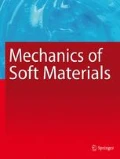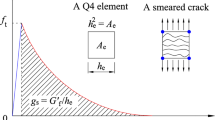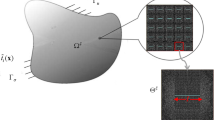Abstract
Phase-field or gradient-damage approaches offer elegant ways to model cracks. Material stiffness decreases in the cracked region with the evolution of the phase-field or damage variable. This variable and, consequently, the decreased stiffness are spatially diffused, which essentially means the loss of the internal links and the bearing capacity of the material in a finite region. Considering the loss of material stiffness without the loss of inertial mass seems to be an incomplete idea when dynamic fracture is considered. Loss of the inertial mass in the damaged material region may have significant effect on the dynamic failure processes. In the present work, dynamic fracture is analyzed using a theory, which takes into account the local loss of both material stiffness and inertia. Numerical formulation for brittle fracture at large deformations is based on the Cosserat point method, which allows suppressing the hourglass type deformation modes in simulations. Based on the developed algorithms, the effect of the material inertia around a crack tip is studied. Two different problems with single and multiple cracks are considered. Results suggest that in dynamic fracture the localized loss of mass plays an important role at the crack tip. It is found, particularly, that the loss of inertia leads to lower stresses at the crack tip and, because of that, to narrower cracks as compared to the case in which no inertia loss is considered. It is also found that the regularized problem formulation provides global convergence in energy under the mesh refinement. At the same time, the local crack pattern might still depend on the geometry of the unstructured mesh.














Similar content being viewed by others
Notes
It should be mentioned here that a higher value of ρcr is used in case II, compared to that in case I. This is because the current value of density is used for the calculation of the stable time increment in case II. Using 𝜖 = 0.001 results in extremely small time steps for elements close to the cracked region, unnecessarily slowing down the simulations. For a few cases, simulations have been performed for similar values of 𝜖 in cases I and II, to ensure that the differences in results between both cases are not only due to different values of ρcr. For S2 results for different values of 𝜖 are shown in Fig. 17 in Appendix 2.
References
Agrawal, V., Dayal, K.: Dependence of equilibrium griffith surface energy on crack speed in phase-field models for fracture coupled to elastodynamics. Int. J. Fract. 207(2), 243–249 (2017)
Barenblatt, G.I.: The formation of equilibrium cracks during brittle fracture. General ideas and hypotheses. Axially-symmetric cracks. J. Appl. Math. Mech. 23(3), 622–636 (1959)
Belytschko, T., Bindeman, L.: Assumed strain stabilization of the 4-node quadrilateral with 1-point quadrature for nonlinear problems. Comput. Methods Appl. Mech. Eng. 88(3), 311–340 (1991)
Belytschko, T., Bindeman, L.P.: Assumed strain stabilization of the eight node hexahedral element. Comput. Methods Appl. Mech. Eng. 105(2), 225–260 (1993)
Benzerga, A.A., Leblond, J.B., Needleman, A., Tvergaard, V.: Ductile failure modeling. Int. J. Fract. 201(1), 29–80 (2016)
Borden, M.J., Verhoosel, C.V., Scott, M.A., Hughes, T.J.R., Landis, C.M.: A phase-field description of dynamic brittle fracture. Comput. Methods Appl. Mech. Eng. 217, 77–95 (2012)
Camacho, G.T., Ortiz, M.: Computational modelling of impact damage in brittle materials. Int. J. Solids Struct. 33(20-22), 2899–2938 (1996)
Chen, C.H., Bouchbinder, E., Karma, A.: Instability in dynamic fracture and the failure of the classical theory of cracks. Nat. Phys. 13(12), 1186 (2017)
De Borst, R.: Some recent issues in computational failure mechanics. Int. J. Numer. Methods Eng. 52(1-2), 63–95 (2001)
De Borst, R, Van Der Giessen, E: Material Instabilities in Solids. Wiley, Chichester (1998)
Dolbow, J., Belytschko, T.: A finite element method for crack growth without remeshing. Int. J. Numer. Methods Eng. 46(1), 131–150 (1999)
Dorfmann, A., Ogden, R.W.: A constitutive model for the mullins effect with permanent set in particle-reinforced rubber. Int. J. Solids Struct. 41(7), 1855–1878 (2004)
Francfort, G.A., Marigo, J.J.: Revisiting brittle fracture as an energy minimization problem. J. Mech. Phys. Solids 46(8), 1319–1342 (1998)
Gong, B., Paggi, M., Carpinteri, A.: A cohesive crack model coupled with damage for interface fatigue problems. Int. J. Fract. 173(2), 91–104 (2012)
Gurson, A.L.: Continuum theory of ductile rupture by void nucleation and growth: Part I. Yield criteria and flow rules for porous ductile media. J. Eng. Mater. Technol. 99(1), 2–15 (1977)
Hofacker, M., Miehe, C.: Continuum phase field modeling of dynamic fracture: variational principles and staggered FE implementation. Int. J. Fract. 178(1-2), 113–129 (2012)
Jabareen, M., Rubin, M.: Hyperelasticity and physical shear buckling of a block predicted by the cosserat point element compared with inelasticity and hourglassing predicted by other element formulations. Comput. Mech. 40(3), 447–459 (2007)
Kachanov, L.M.: Time of the rupture process under creep conditions, izy akad. Nank SSR Otd Tech Nauk 8, 26–31 (1958)
Karma, A., Kessler, D.A., Levine, H.: Phase-field model of mode iii dynamic fracture. Phys. Rev. Lett. 87(4), 045,501 (2001)
Klein, P., Gao, H.: Crack nucleation and growth as strain localization in a virtual-bond continuum. Eng. Fract. Mech. 61(1), 21–48 (1998)
Lasry, D., Belytschko, T.: Localization limiters in transient problems. Int. J. Solids Struct. 24(6), 581–597 (1988)
Lemaitre, J., Desmorat, R.: Engineering Damage Mechanics: Ductile, Creep, Fatigue and Brittle Failures. Springer, Berlin (2005)
Menzel, A., Steinmann, P.: A theoretical and computational framework for anisotropic continuum damage mechanics at large strains. Int. J. Solids Struct. 38(52), 9505–9523 (2001)
Mtanes, E., Jabareen, M.: A plane strain quadrilateral cosserat point element (cpe) for nonlinear orthotropic elastic materials: An extension to initially distorted geometry and general orthotropic directions. Finite Elem. Anal. Des. 87, 10–21 (2014)
Needleman, A.: A continuum model for void nucleation by inclusion debonding. J. Appl. Mech. 54(3), 525–531 (1987)
Needleman, A.: Some issues in cohesive surface modeling. Procedia IUTAM 10, 221–246 (2014)
Park, K., Paulino, G.H., Roesler, J.R.: A unified potential-based cohesive model of mixed-mode fracture. J. Mech. Phys. Solids 57(6), 891–908 (2009)
Peerlings, R.H.J., De Borst, R., Brekelmans, W.A.M., De Vree, J.H.P.: Gradient enhanced damage for quasi-brittle materials. Int. J. Numer. Methods Eng. 39, 3391–3403 (1996)
Peerlings, R.H.J., De Borst, R., Brekelmans, W.A.M., De Vree, J.H.P., Spee, I.: Some observations on localisation in non-local and gradient damage models. Eur. J. Mech. A. Solids 15(6), 937–953 (1996)
Peerlings, R.H.J., Brekelmans, W.A.M., De Borst, R., Geers, M.G.D.: Softening, singularity and mesh sensitivity in quasi-brittle and fatigue damage, in nonlocal aspects in solid mechanics. In: Proceedings of EUROMECH Colloquium, vol. 378, pp 94–99 (1998)
Peerlings, R.H.J., De Borst, R., Brekelmans, W.A.M., Geers, M.G.D.: Localisation issues in local and nonlocal continuum approaches to fracture. Eur. J. Mech. A. Solids 21(2), 175–189 (2002)
Pian, T.H., Sumihara, K.: Rational approach for assumed stress finite elements. Int. J. Numer. Methods Eng. 20(9), 1685–1695 (1984)
Pijaudier-Cabot, G., Bažant, Z.P.: Nonlocal damage theory. J. Eng. Mech. 113(10), 1512–1533 (1987)
Raghavan, M.L., Vorp, D.A.: Toward a biomechanical tool to evaluate rupture potential of abdominal aortic aneurysm: identification of a finite strain constitutive model and evaluation of its applicability. J. Biomech. 33(4), 475–482 (2000)
Rice, J.R., Wang, J.S.: Embrittlement of interfaces by solute segregation. Mater. Sci. Eng. A 107, 23–40 (1989)
Silling, S.A.: Reformulation of elasticity theory for discontinuities and long-range forces. J. Mech. Phys. Solids 48(1), 175–209 (2000)
Simo, J., Armero, F., Taylor, R.: Improved versions of assumed enhanced strain tri-linear elements for 3d finite deformation problems. Comput. Methods Appl. Mech. Eng. 110(3-4), 359–386 (1993)
Simo, J.C.: On a fully three-dimensional finite-strain viscoelastic damage model: formulation and computational aspects. Comput. Methods Appl. Mech. Eng. 60(2), 153–173 (1987)
Simo, J.C., Armero, F.: Geometrically non-linear enhanced strain mixed methods and the method of incompatible modes. Int. J. Numer. Methods Eng. 33(7), 1413–1449 (1992)
Taylor, RL: FEAP - finite element analysis program. http://www.ce.berkeley/feap (2014)
Taylor, RL: FEAP - finite element analysis program: Version 8.4 programmer manual. http://www.ce.berkeley/feap/pmanual84.pdf (2014)
Taylor, R.L.: FEAP - finite element analysis program: Version 8.4 user manual. http://www.ce.berkeley/feap/manual84.pdf (2014)
Tvergaard, V., Hutchinson, J.W.: The relation between crack growth resistance and fracture process parameters in elastic-plastic solids. J. Mech. Phys. Solids 40(6), 1377–1397 (1992)
Volokh, K.Y.: Nonlinear elasticity for modeling fracture of isotropic brittle solids. J. Appl. Mech. 71(1), 141–143 (2004)
Volokh, K.Y.: Hyperelasticity with softening for modeling materials failure. J. Mech. Phys. Solids 55(10), 2237–2264 (2007)
Volokh, K.Y.: Review of the energy limiters approach to modeling failure of rubber. Rubber Chem. Technol. 86(3), 470–487 (2013)
Volokh, K.Y.: Mechanics of Soft Materials. Springer, Singapore (2016)
Volokh, K.Y.: Fracture as a material sink. Materials Theory 1(1), 3 (2017)
Voyiadjis, G.Z., Kattan, P.I.: A plasticity-damage theory for large deformation of solids-I. theoretical formulation. Int. J. Eng. Sci. 30(9), 1089–1108 (1992)
Xu, X.P., Needleman, A.: Numerical simulations of fast crack growth in brittle solids. J. Mech. Phys. Solids 42(9), 1397–1434 (1994)
Acknowledgments
The authors thank Prof. Mahmood Jabareen for introducing them to the CPE formulation and the valuable discussion on it.
Funding
The authors acknowledge the support from the Israel Science Foundation, grant No. ISF-198/15.
Author information
Authors and Affiliations
Corresponding author
Ethics declarations
Conflict of interest
The authors declare that they have no conflict of interest.
Additional information
Publisher’s note
Springer Nature remains neutral with regard to jurisdictional claims in published maps and institutional affiliations.
Appendices
Appendix 1. Results for coarse mesh
Appendix 2. Effect of critical density on crack propagation
Using similar values of 𝜖 in cases I and II, crack propagation for mesh S2 is compared in Fig. 17. For case I, higher value of 𝜖 results in a slightly thicker crack, whereas, for case II, it changes the crack growth pattern.
Rights and permissions
About this article
Cite this article
Faye, A., Lev, Y. & Volokh, K.Y. The effect of local inertia around the crack-tip in dynamic fracture of soft materials. Mech Soft Mater 1, 4 (2019). https://doi.org/10.1007/s42558-019-0004-2
Received:
Accepted:
Published:
DOI: https://doi.org/10.1007/s42558-019-0004-2







